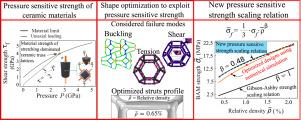Better than linear strength scaling of multifunctional ceramic truss lattice materials
IF 7.1
1区 工程技术
Q1 ENGINEERING, MECHANICAL
International Journal of Mechanical Sciences
Pub Date : 2024-09-26
DOI:10.1016/j.ijmecsci.2024.109725
引用次数: 0
Abstract
Driven by the goal of creating exceptionally strong and lightweight thermal insulators to enable the operation of a vacuum airship on Venus, conditions where ceramic truss lattice materials provide better than linear scaling of strength with respect to variations in relative density have been found. This enhanced scaling relationship is a consequence of the pressure sensitive shear strength of ceramic materials. A new Gibson-Ashby type scaling relationship is developed between strength and relative density. Elementary analysis is used to formulate theoretical limits for the compressive strength, minimum density, and minimum thermal conductivity for truss lattice materials subjected to hydrostatic pressure loads. Shape optimization using the covariance matrix adopted evolutionary strategy (CMA-ES) and highly resolved finite element models is conducted on silicon carbide Kelvin cells with variable cross-section axisymmetric struts considering three failure modes: buckling, tensile rupture, and shear failure. The optimized designs closely adhere to and validate the newly developed analytical scaling relationship with better than linear strength scaling. These optimized designs are found to withstand the extreme loading conditions on Venus while providing up to 43 of buoyancy. The thermal conductivity of the optimized designs are computed and found to be less than 0.5 , with one design outperforming silica aerogels at elevated temperature.

多功能陶瓷桁架晶格材料的强度比例优于线性比例
为了实现在金星上运行真空飞艇的目标,人们发现陶瓷桁架晶格材料的强度随相对密度变化的比例关系优于线性比例关系。这种增强的比例关系是陶瓷材料对压力敏感的剪切强度的结果。在强度和相对密度之间建立了一种新的 Gibson-Ashby 型比例关系。通过基本分析,为承受静水压力载荷的桁架晶格材料制定了抗压强度、最小密度和最小导热系数的理论极限。采用协方差矩阵进化策略(CMA-ES)和高分辨率有限元模型,对具有可变截面轴对称支柱的碳化硅开尔文电池进行了形状优化,考虑了三种失效模式:屈曲、拉伸断裂和剪切失效。优化设计与新开发的分析缩放关系密切相关,并验证了其优于线性强度缩放关系。这些优化设计能够承受金星上的极端载荷条件,同时提供高达 43 kgm3 的浮力。通过计算发现,优化设计的导热系数小于 0.5 WmK,其中一种设计在高温下的性能优于二氧化硅气凝胶。
本文章由计算机程序翻译,如有差异,请以英文原文为准。
求助全文
约1分钟内获得全文
求助全文
来源期刊

International Journal of Mechanical Sciences
工程技术-工程:机械
CiteScore
12.80
自引率
17.80%
发文量
769
审稿时长
19 days
期刊介绍:
The International Journal of Mechanical Sciences (IJMS) serves as a global platform for the publication and dissemination of original research that contributes to a deeper scientific understanding of the fundamental disciplines within mechanical, civil, and material engineering.
The primary focus of IJMS is to showcase innovative and ground-breaking work that utilizes analytical and computational modeling techniques, such as Finite Element Method (FEM), Boundary Element Method (BEM), and mesh-free methods, among others. These modeling methods are applied to diverse fields including rigid-body mechanics (e.g., dynamics, vibration, stability), structural mechanics, metal forming, advanced materials (e.g., metals, composites, cellular, smart) behavior and applications, impact mechanics, strain localization, and other nonlinear effects (e.g., large deflections, plasticity, fracture).
Additionally, IJMS covers the realms of fluid mechanics (both external and internal flows), tribology, thermodynamics, and materials processing. These subjects collectively form the core of the journal's content.
In summary, IJMS provides a prestigious platform for researchers to present their original contributions, shedding light on analytical and computational modeling methods in various areas of mechanical engineering, as well as exploring the behavior and application of advanced materials, fluid mechanics, thermodynamics, and materials processing.
 求助内容:
求助内容: 应助结果提醒方式:
应助结果提醒方式:


